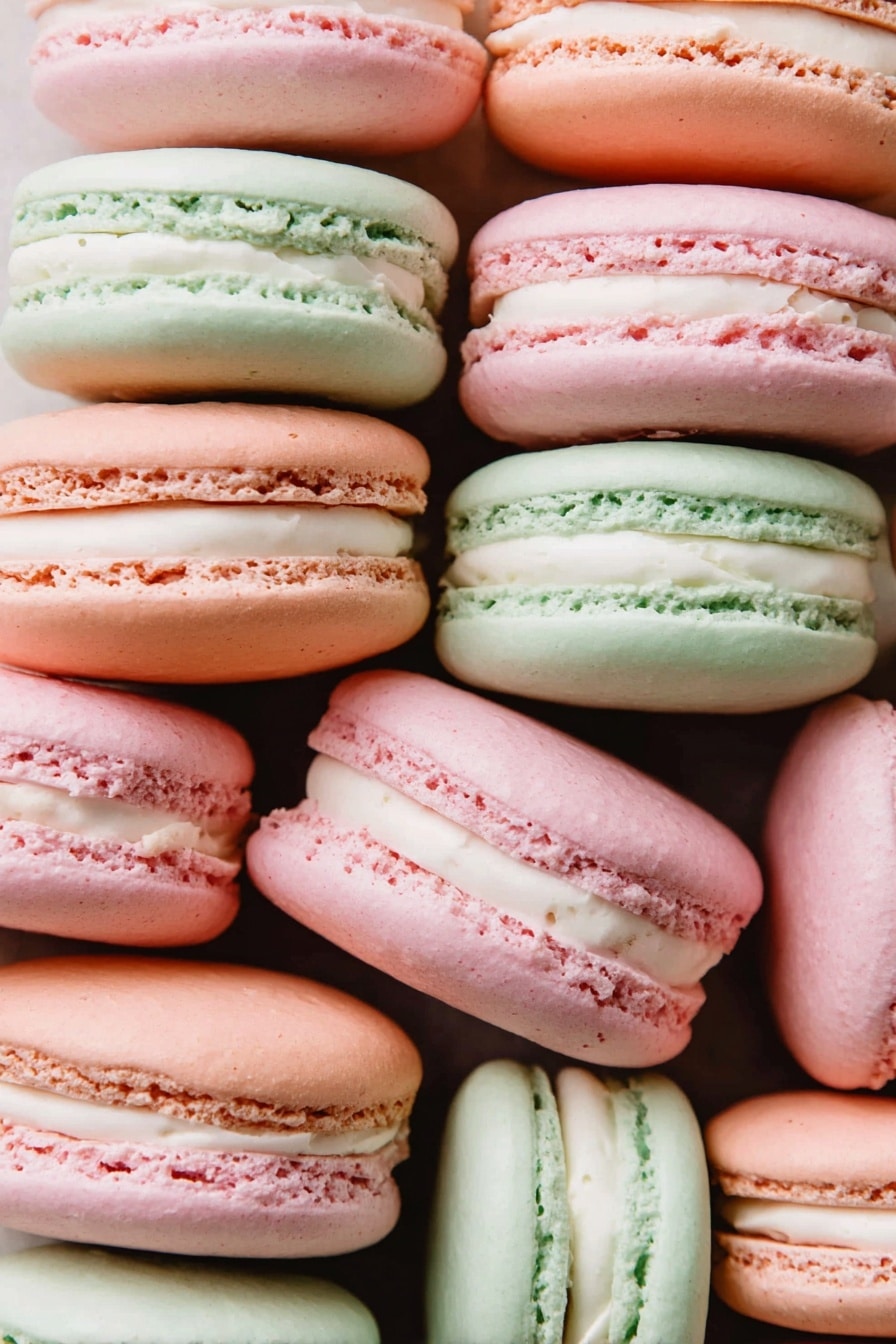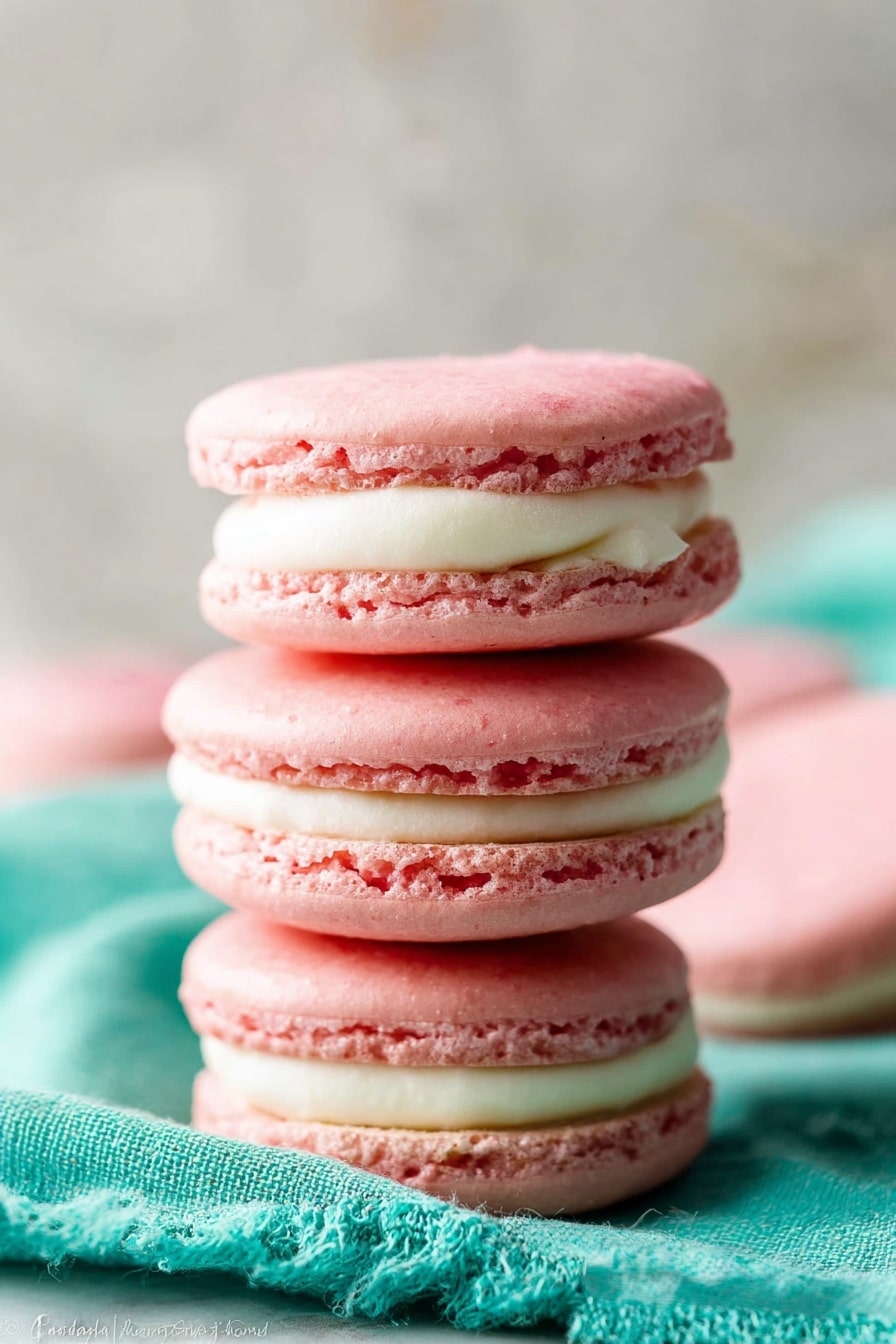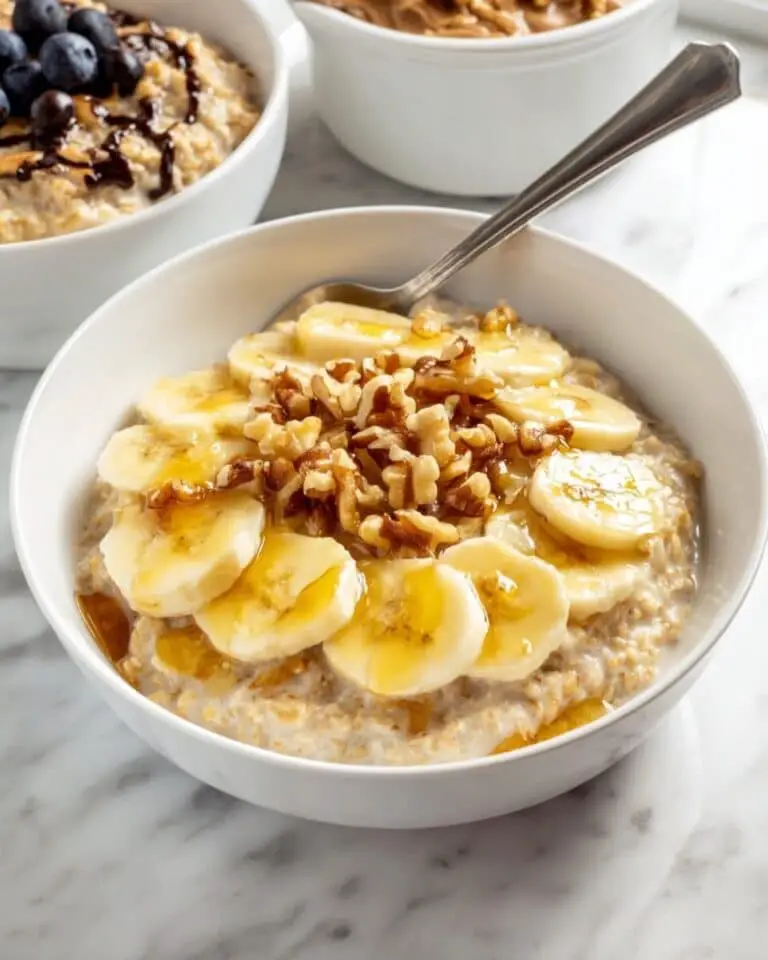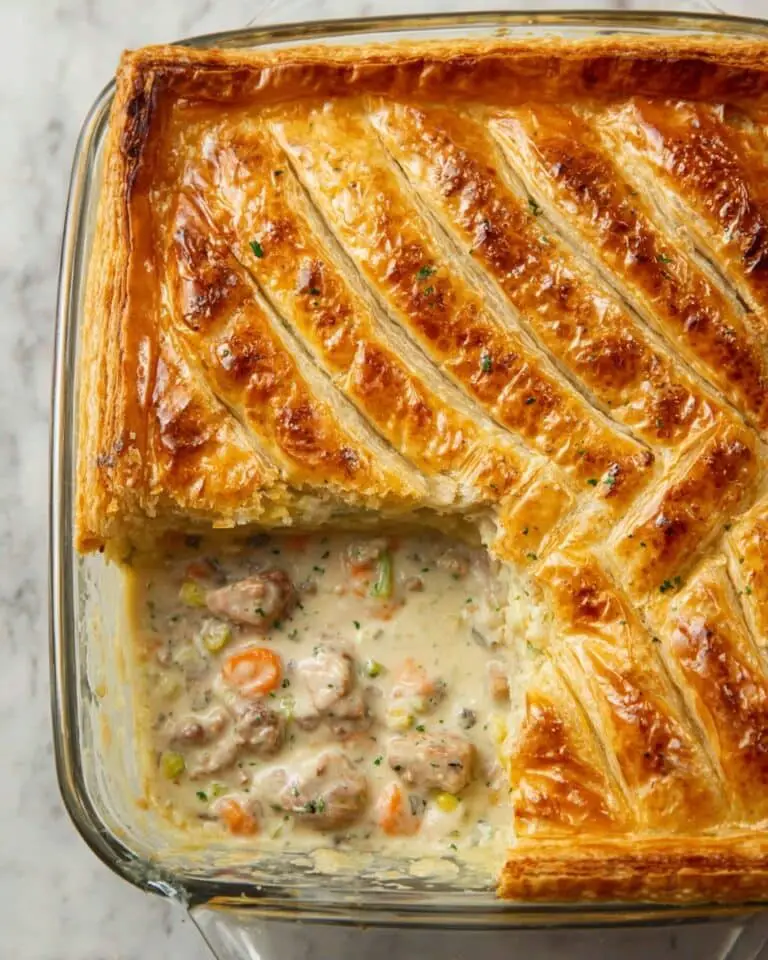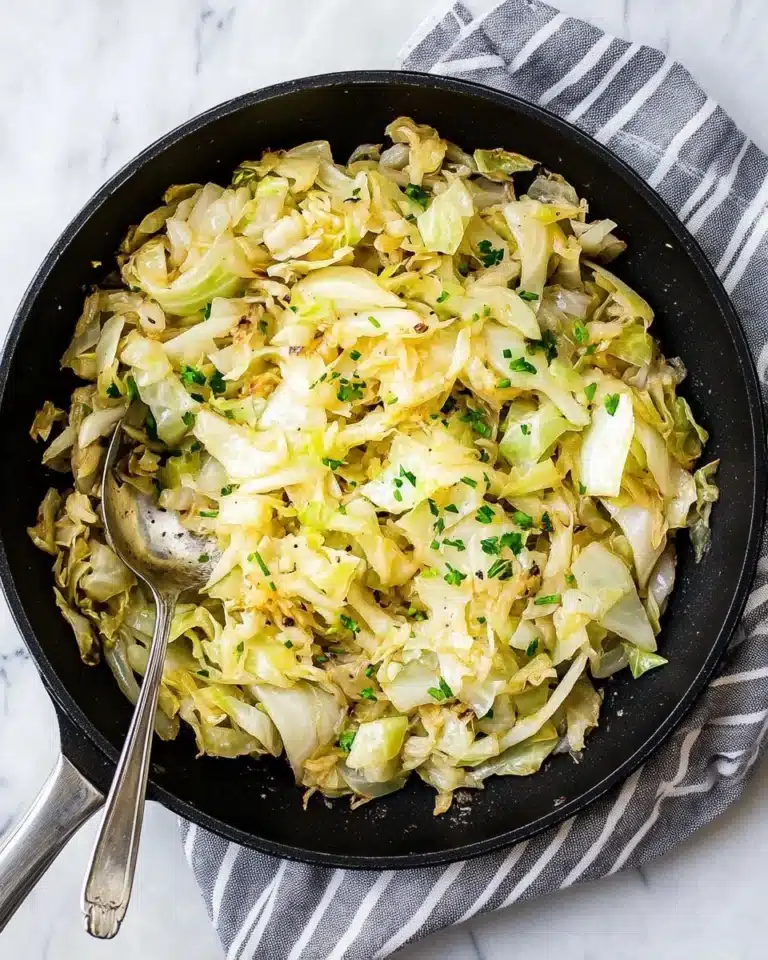If you’ve ever dreamed of baking those delicate, charming little cookies with a crisp shell and soft, chewy center, then this French Macarons Recipe is the perfect treat to try in your own kitchen. I absolutely love how these macarons turn out—so elegant and surprisingly achievable once you know a few tricks. Whether you’re a seasoned baker or giving macarons a first shot, stick with me here because I promise you’ll find this recipe fan-freaking-tastic and truly worth the effort!
Why You’ll Love This Recipe
- Effort Meets Elegance: You’ll be amazed how a few simple ingredients transform into these beautiful, bakery-worthy treats.
- Foolproof Method: Through my personal experience, I share tips that turn tricky steps into smooth sailing.
- Customizable Flavors: You can play with extracts and fillings to make each batch your own signature creation.
- Impressive Yet Approachable: Perfect for special occasions or just a treat to brighten any day.
Ingredients You’ll Need
These ingredients come together in perfect harmony to create the iconic smooth tops and ruffled “feet” that define the French macaron. Using superfine sugar and finely sifted almond flour is key for that velvety texture you’ll love.
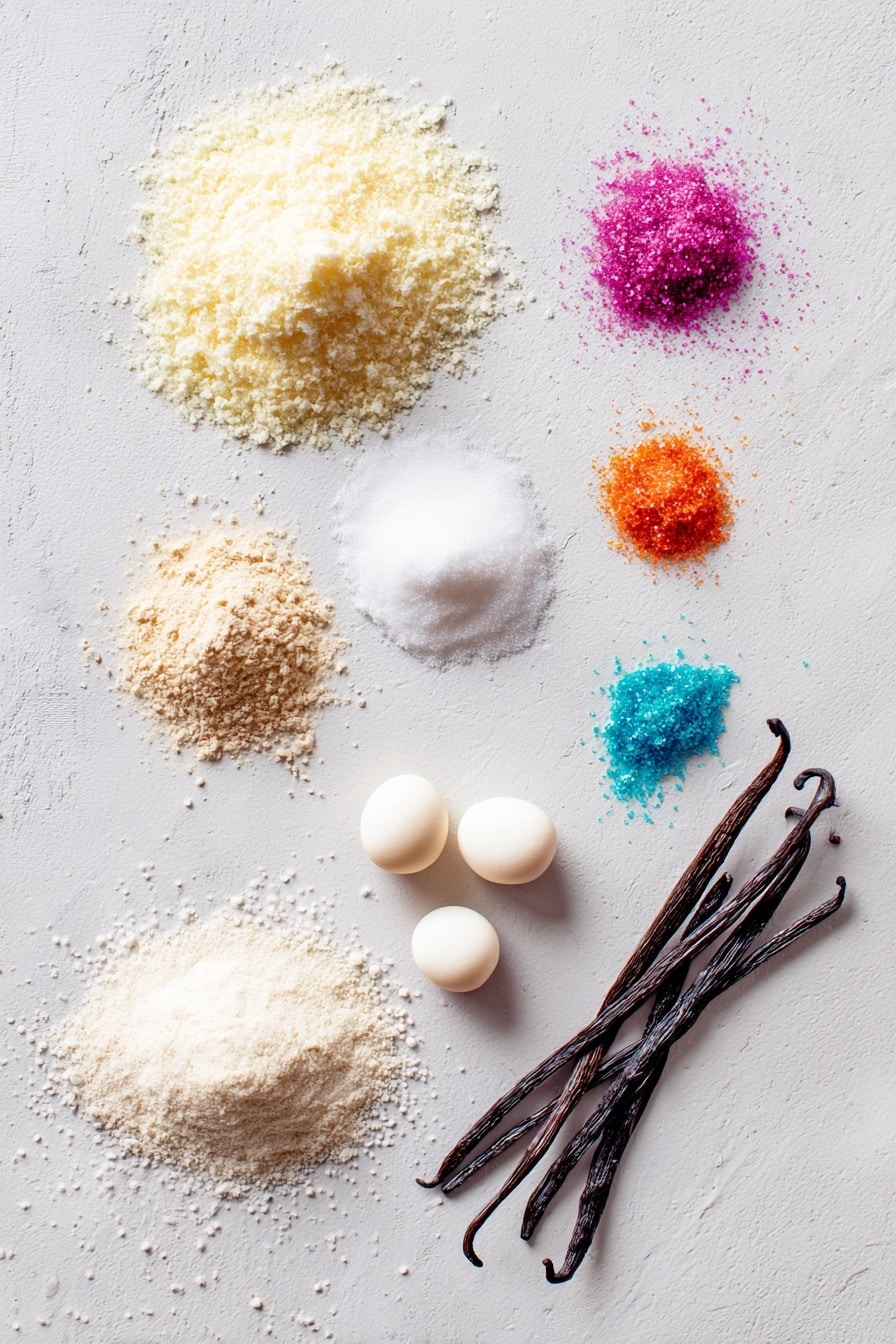
- Egg whites: Fresh, room temperature is essential for volume; I find aging them in the fridge overnight makes the best meringue.
- Cream of tartar: Stabilizes the egg whites and helps achieve those stiff peaks we all need.
- Extract (vanilla, almond, coconut, etc.): Optional, but adding flavor makes your macarons uniquely yours. Experiment and have fun!
- Superfine sugar (caster sugar): Dissolves quickly into the egg whites for a glossy meringue; regular granulated sugar can make the texture grainy.
- Gel food coloring: Just a couple drops give vibrant colors without watering down the batter.
- Almond flour: Sifted finely for smooth shells—right texture is critical here.
- Confectioners’ sugar: Blended with almond flour to lend sweetness and that delicate crumb.
- Macaron filling: Whether buttercream, ganache, or jam, filling options are endless and super fun to customize.
Variations
I love to mix things up by playing with flavors and colors depending on the season or occasion. Don’t hesitate to make this French Macarons Recipe truly yours with these easy twists!
- Fruit-Flavored Filling: Adding a fresh raspberry or passion fruit buttercream gives a bright, tangy contrast to the nutty shells—my family goes crazy for it!
- Chocolate Lovers’ Dream: Swapping the filling for rich ganache makes these even more decadent.
- Dietary Tweaks: I’ve successfully made this recipe gluten-free (natural due to almond flour) and dairy-free by using coconut cream-based fillings—always a hit with guests.
- Fun Colors & Patterns: Try swirling two colors on your piping bag tip or add edible glitter for a party-ready vibe.
How to Make French Macarons Recipe
Step 1: Prep the Egg Whites Like a Pro
This is the secret that often trips people up—the 24-hour rest for your egg whites. I discovered this trick early on and it truly makes a difference. Wipe your mixing bowl with lemon juice or vinegar to get rid of grease (trust me, even the tiniest bit prevents your whites from whipping properly). Add the whites, cover, and chill overnight. When you bring them out and whip them, you’ll notice they gain amazing volume and stability, which is why this step is key!
Step 2: Whip Your Meringue to Perfect Peaks
Add cream of tartar and your chosen extract to the egg whites, then start beating with a mixer. Watch for those soft peaks—the point when the egg whites hold their shape but still bend a little. Then the slow, gradual addition of superfine sugar is crucial. Adding sugar bit by bit while whipping leads to a shiny, stiff meringue that you can confidently fold into your dry ingredients. A quick tip: if you can turn your bowl upside down and the meringue doesn’t move—that’s stiff peaks, baby!
Step 3: Fold with Care—Get That Perfect Batter
Sift almond flour and confectioners’ sugar together to keep things super fine, then gently fold your meringue into this dry mix in thirds. This folding is both the art and science behind macarons. You want to deflate some air but keep enough to get those lovely feet. The ‘figure 8 test’ helps me know when it’s just right—the batter should flow slowly and smooth into itself in about 10 seconds. Go slowly and patiently here; overmixing can make your macarons flat and under-mixing leaves them lumpy.
Step 4: Pipe and Dry Before Baking
Spoon your batter into a piping bag fitted with a round tip, then pipe small rounds onto prepared baking sheets. You’ll want them about 1-2 inches apart since they spread a bit. Then, bang the tray on the counter to pop air bubbles and use a toothpick for any stubborn bubbles. Here’s where patience pays off: let them rest at room temperature until a skin forms on top—usually 30-60 minutes. This skin helps create those signature feet, so don’t rush it!
Step 5: Bake and Cool Like a Pro
Preheat your oven to 325°F (163°C) and bake for about 13 minutes. Around this time, you’ll see the feet form—such a satisfying moment! Test doneness by gently touching the top of a shell; if it’s wobbly, give it 1-2 more minutes. Let them cool fully on the baking sheet before moving to a rack—this keeps the fragile shells intact. If they stick, just give them a little more time to cool before peeling.
Step 6: Fill and Enjoy
Once cooled, pair up your shells and fill them with your choice of buttercream, ganache, or preserves. I like piping the filling for a neat look, but spreading works, too. Some people refrigerate their macarons to let the flavors meld and soften the texture—feel free to try both and see what you prefer. Just remember to bring them back to room temp before serving for the best flavor.
Pro Tips for Making French Macarons Recipe
- Bowl Prep Is Key: Always wipe your mixing bowls clean with an acid like lemon or vinegar to remove oils that can deflate whites.
- Patience During Drying: Don’t skip the drying stage before baking—it’s what helps macarons rise perfectly.
- Use a Kitchen Scale: I learned the hard way that weighing ingredients leads to consistent, repeatable macarons.
- Gentle Folding: Fold slowly and carefully to maintain air but reach the right batter consistency—this balance is everything!
How to Serve French Macarons Recipe
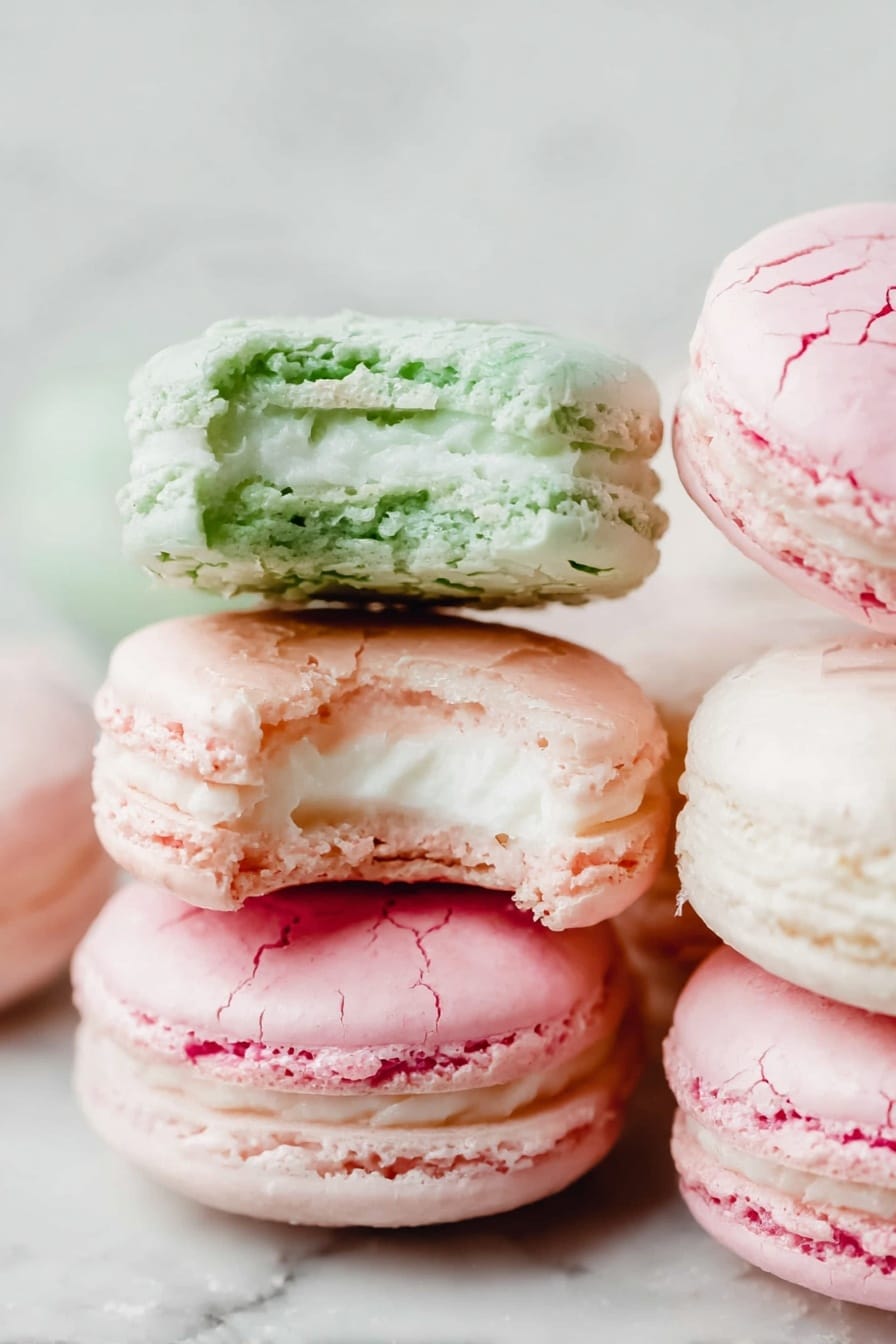
Garnishes
For toppings, I like a light dusting of edible glitter or a sprinkle of finely chopped pistachios right on the filling. It adds a little wow factor and complements the almond shells beautifully.
Side Dishes
Macarons pair beautifully with afternoon tea—think Earl Grey or jasmine green tea. For a celebration, serve them alongside fresh berries and lightly whipped cream for a delicate, refined dessert spread.
Creative Ways to Present
I love arranging macarons in a colorful tower or on elegant tiered trays for parties. Another fun idea I’ve tried is gifting them in small, clear boxes tied with ribbons—you’ll get compliments guaranteed, as everyone loves receiving these beauties.
Make Ahead and Storage
Storing Leftovers
After filling, cover your macarons tightly and refrigerate for up to 5 days. I’ve found that storing in an airtight container keeps them fresh and chewy, but be sure to bring them back to room temperature before serving for best texture and flavor.
Freezing
Macarons freeze really well! I usually freeze them unfilled in a single layer on a tray, then transfer to a sealed bag or container. When I’m ready, I thaw them completely before filling—this way, they keep their delicate texture without condensation messing things up.
Reheating
No need to reheat macarons! Just let frozen or refrigerated ones come to room temperature naturally—they taste best that way. If you’re serving chilled, a quick 10-minute rest on the counter usually does the trick to bring out the flavors.
FAQs
-
What causes French macarons to crack?
Cracking usually happens if the batter is too dry, if the drying time before baking is too short, or if the oven temperature is too high. Make sure to let your piped macarons rest until the tops form a dry skin before baking, and consider using an oven thermometer to ensure accurate temperature.
-
How do I get the perfect “feet” on my macarons?
The key is the drying step before baking and the right oven temperature. Drying allows the skins to form, which supports the rise and feet formation, while an oven that’s too hot or too cool can prevent feet. Also, folding the batter to the right consistency ensures proper air retention needed for feet.
-
Can I use regular granulated sugar instead of superfine sugar?
Superfine sugar dissolves more easily into the egg whites, giving a smooth, glossy meringue. Using regular granulated sugar can result in gritty texture and an unstable meringue, so superfine sugar or caster sugar is highly recommended for the best results.
-
What fillings work best for French macarons?
Buttercream, ganache, lemon curd, fruit jams, and cream cheese fillings are all popular and delicious choices. Choose the ones you love and don’t be afraid to mix flavors—this recipe is super flexible!
-
Do I need a kitchen scale for this French Macarons Recipe?
While some bakers get by with volume measures, I highly recommend using a kitchen scale for accuracy. I learned that precise grams make a huge difference in achieving consistent macarons every time.
Final Thoughts
This French Macarons Recipe has a special place in my heart because it taught me patience and precision while rewarding me with incredible results that wow family and friends. If I can do it, you can, too—just take your time, trust the process, and enjoy the joyful moment when you bite into that perfectly chewy, melt-in-your-mouth cookie. Give it a try, and soon these elegant little gems will be a beloved staple in your kitchen as well!
Print
French Macarons Recipe
- Prep Time: 1 hr
- Cook Time: 13 min
- Total Time: 1 hr 30 min
- Yield: 40 shells, about 20 sandwiched macarons
- Category: Dessert
- Method: Baking
- Cuisine: French
- Diet: Vegetarian
Description
Classic French macarons are delicate, crisp, and chewy almond meringue cookies sandwiched with your choice of flavorful fillings. This recipe guides you through the process of making perfect macarons with smooth, glossy shells and the iconic ruffled feet, ideal for celebrations or elegant treats.
Ingredients
Egg White Mixture
- 100g egg whites (about 3–4 large egg whites)
- 1/4 teaspoon (1g) cream of tartar
- 1/2 teaspoon extract such as vanilla, almond, coconut, etc. (optional)
- 80g superfine sugar (caster sugar)
- 1–2 drops gel food coloring (optional)
Dry Ingredients
- 125g almond flour
- 125g confectioners’ sugar
Filling
- Desired macaron filling (e.g., buttercream, ganache, jam, or curd)
Instructions
- Prepare Egg Whites: Wipe down a large glass or metal mixing bowl with lemon juice or vinegar to remove grease. Add egg whites, cover, and refrigerate for 24 hours, then bring to room temperature before use.
- Line Baking Sheets: Line 3 large baking sheets with silicone baking mats or parchment paper to prevent sticking.
- Beat Egg Whites: Add cream of tartar and extract (if using) to egg whites. Beat with a mixer on medium speed until soft peaks form. Gradually add superfine sugar in three additions while increasing speed to medium-high, beating until stiff, glossy peaks form.
- Add Food Coloring: Gently fold in gel food coloring using a rubber spatula if desired, taking care not to deflate the meringue.
- Sift Dry Ingredients: Sift almond flour and confectioners’ sugar together in a large bowl, breaking up any clumps with a spoon to ensure even mixing.
- Combine Mixtures: Fold beaten egg whites into the almond flour mixture in three parts. After incorporating all, continue folding until batter reaches the consistency of honey. Use the figure 8 test; batter should take about 10 seconds to blend back to itself.
- Pipe Macarons: Transfer batter to a piping bag fitted with a medium round tip. Pipe 1.5–2 inch rounds spaced 1-2 inches apart onto prepared sheets. Tap trays on the countertop to release air bubbles and pop bubbles with a toothpick if necessary.
- Rest the Shells: Let piped macarons dry at room temperature for 30–60 minutes until they develop a dry, tack-free skin surface to help form feet during baking.
- Preheat Oven: Preheat oven to 325°F (163°C).
- Bake: Bake macarons for 13 minutes. Check doneness by gently touching the top; if it’s firm and not wobbly, they are done. Otherwise, bake 1–2 minutes longer.
- Cool Shells: Let shells cool on baking sheets for 15 minutes before transferring to a wire rack to cool completely. This prevents sticking and breaks.
- Assemble Macarons: Once cooled, sandwich shells with your choice of filling. Fillings can be spread or piped for neat assembly.
- Optional Maturing: Refrigerate assembled macarons covered for 12–24 hours to mature flavors. Bring to room temperature before serving.
- Storage: Store leftovers in an airtight container in the refrigerator for up to 5 days.
Notes
- Use a kitchen scale to measure ingredients for best accuracy.
- Superfine sugar ensures a smooth meringue; if not available, lightly process granulated sugar in a blender.
- Letting shells rest before baking is crucial for developing feet and preventing cracking.
- Handle batter gently to avoid overmixing which can cause flat or cracked macarons.
- Experiment with different extracts and fillings to customize flavor—common fillings include buttercream, ganache, jam, or curd.
- If shells stick when cooling, allow more time on the baking sheet to set.
- To troubleshoot flat macarons or no feet, review meringue stiffness and resting period.
Nutrition
- Serving Size: 2 macarons (approx. 28g)
- Calories: 110
- Sugar: 15g
- Sodium: 5mg
- Fat: 4g
- Saturated Fat: 0.5g
- Unsaturated Fat: 3.5g
- Trans Fat: 0g
- Carbohydrates: 16g
- Fiber: 1g
- Protein: 3g
- Cholesterol: 0mg

